Planting of commercial plants
Farming is an important segment that contributes to the creation of food to ensure our survival. In my project to achieve a fuller life in the early days, my work experiments involved growing food crops such as soybeans, Arachis hypogaea and corn using “Primitive skills” methods. The tools I use are: primitive axes, wooden spades, wooden picks, bamboo tubes, bamboo baskets and “sieves” to hold varieties.
I started by grinding the original ax. I went to the forest to get Phrynium leaves to wrap soaked seeds, these leaves are very much in the forest where they usually grow in the lowlands near the stream. Phrynium leaves are usually wide with a width of 10-25cm, 30-100cm long, depending on whether the land it grows is good or bad. Choose large leaves that are not torn, not too old and not too young, I will choose about 30 leaves to use.
Clean the bamboo basket, “sieve”, check the seeds contained in the bamboo tube.
The seeds have been collected in the wild (see here), in the video shows you where I got the seeds and I cleaned, separated, sorted, dried and carefully stored in bamboo tubes. to avoid termites.
Next is the treatment of plant varieties:
Check the seeds in turn: Arachis hypogaea, Glycine max and corn seeds from bamboo tubes into a “sieve”. Use “sieve” to remove small, bad particles according to “Primitive skills“. The goal is for me to choose the best seeds to use for planting.
Strip and arrange the leaf cushions in bamboo baskets together to capture them together (see here), and then put the varieties in. divided into 2 floors: the lower floor contains maize varieties, the upper floor contains peanuts. fold the seedling leaf so that it will not mix between the two varieties, which will be easier for planting. Bringing the seed container soaked in water to submerge the seed, it was important to make sure the water was always flooded, soaking the seed and I used stone to wrap the seed so that the seed didn’t drift away. Build stones around them to make sure the barrel is always in place. Depending on how long a variety of varieties is left to soak, such as the “Maize” variety we soak for at least 2 nights so that we can scoop out the seeds and watch for signs of hatching. from the water and then incubation, the compost I will talk in detail, the procedure for you to know below. For peanuts, this type of tree time and composting process is shorter.
Soybean varieties just need to remove bad seeds, small seeds. Clean and can be planted immediately.
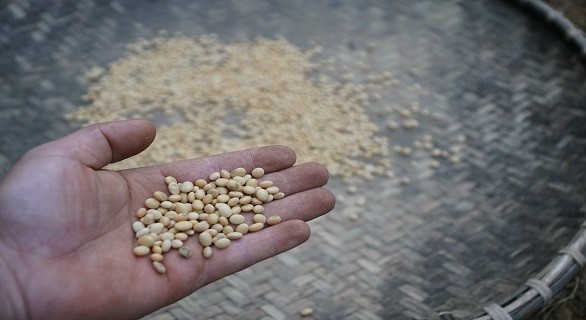 (soybean varieties)
(soybean varieties)
In the process of distributing the above planting sites, I went to check the cassava garden that I planted 9 months ago. Previously, the “primitive skills“ had taken seeds from the wild cassava to plant (see here). So far, the cassava garden has passed my head and it is probably time to harvest it.
After a long time I did not clean them, so the grass here looked too bushy. I proceeded to uproot and use the “Primitive skills” ax, clean the cassava garden and distribute the surrounding area to gain more land to plant new trees that I had previously treated. After I cleared the grass from the garden, I used a peach wood spear and took out the first cassava roots and checked to see if the bulbs were big. It was very happy that the first cassava root gave me 9 big and beautiful bulbs, more specifically, it was the product of the “Primitive skill” effort. Looking at the old cassava branches and many dry branches we see the time it matured not easy at all. That makes us more respectful than what we have experienced in life. “Only when we are devoted and wholeheartedly because of that will we be happy.”
I lit the fire, cleaned quickly, and then put the cassava roots in the fire to grill. While waiting for it to ripen, I started using the wooden spear to start digging. After digging more than half of the garden land and at the same time the sweet cassava roots were ripe, I stopped to enjoy them. When ripe, cassava roots are really very interesting, very fragrant (see here), now I invite you to “Primitive skills” to enjoy them. Oh God, it smells good, smells great, it’s a perfection that everyone wants to experience once. After enjoying the results of effort “Primitive skills” for nine months, I continued digging the remaining soil and using a wooden pickaxe to grind the soil to make sure that the seed after sowing would grow and clean.
Seeds after soaking time above, I picked them up to check, see seeds showing signs of germination, then wrapped with Phrynium placentarium leaves incubated in the basket by folding Phrynium placentarium leaves to not open holes, light or wind , keep the inside temperature the warmest way. The more we keep warm at this time, the faster and faster the germination rate will be, evenly in the condition of avoiding sunlight and rain so that it is not affected. Continuing after 2 days I spent time checking to see if the seeds sprouted or not,
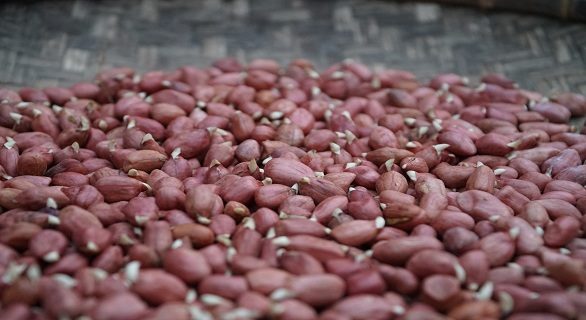
(Peanut seeds)
I put them on 2 different “sieves”, one containing corn kernels and the other containing peanuts.
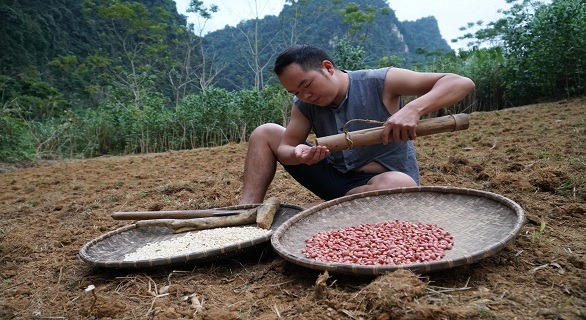
(conduct seed tests)
Next, bring them along with the bamboo tubes of soybeans to grow.
Steps to plant according to “Primitive skills” (using a hoe to dig holes):
- For corn and soybeans, we choose holes 3cm-5cm deep, plants spaced 30cm apart, 50 cm spacing. Sow 3 seeds on each hole, cover them with a thin layer of soil and apply moderate pressure on them
- For peanuts we use a wooden pickaxe to make rows 35cm apart, then sow the seeds so that the seeds are 15cm away. Next, we applied a small layer of granular soil and then compacted it like growing corn and soybeans.
After planting, it started to get dark, and I removed my tools and took it home. Hopefully it will grow evenly and as well as cassava.
Thank you for reading through the article on “Primitiveskills.net“. Wish you the best.
See you next post !!!
the kind of tool that I used in the “video”
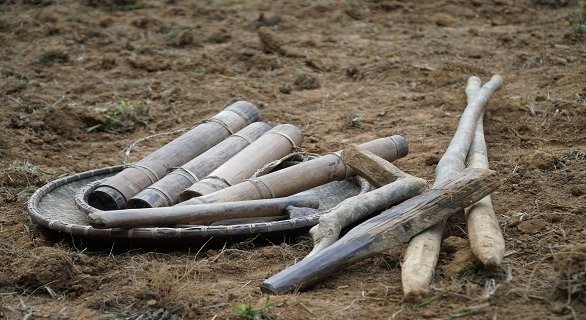
(all tools used)




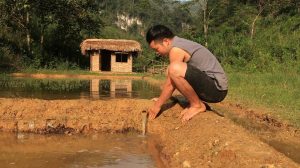
como es que no crias gallinas en un corral con maiz y las engordas para alimentarte luego con la deztreza que tienes para trabajar el bamnu, gracias por hacerme disfrutar de tus hazañas